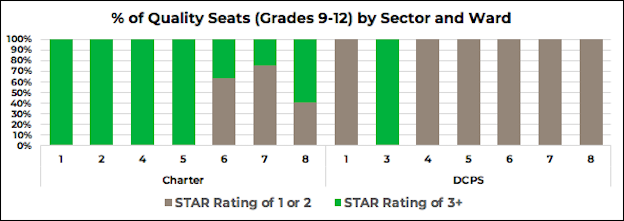Why DC Needs More Quality Schools
Earlier this week DC Public Charter School Board released an analysis using STAR rating data that shows 66.3% of public charter school students attend a 3, 4, or 5 STAR school, compared to 50.2% of DCPS students. Until every student is attending a high quality (3 STAR or higher) school, it is our mission to provide quality public school options for DC students and families. One of the ways we do this is by approving new schools through our comprehensive charter application process. This year, 11 local founding teams made up of current public school parents, teachers, and educators submitted proposals to open new programs because they believe their schools will offer new, innovative approaches to education and help to close the achievement gap that exists today.
Despite concerns about “under-utilization” by the DC Deputy Mayor of Education, families are choosing public charter schools for their students. This year, 59% of public charter schools had longer waitlists than they did last year, and roughly 67% of applicants on waitlists are waiting for a seat at a top-ranking public charter school. Quality matters to families. This is why we want to ensure that there are excellent options available throughout the city.
Currently, public charter schools offer the only 4 STAR schools in Wards 7 and 8, across seven different schools that educate grades PK3-12. Outside of Ward 3, 23.6% of DCPS students in schools with STAR scores attend a 4 or 5 STAR school, compared to 32.5% of public charter school students. As the graph below shows, there is a need to provide more quality middle school seats for families residing in Wards 5, 7, and 8, in particular.

(Note: Graph shows quality seats for SY 2018-19 enrollment data and SY 2017-18 STAR Rating data, excluding schools that did not earn a STAR rating.)
Despite only two applicant groups seeking to locate in Wards 7 and 8, we know getting access to vacant DCPS facilities is a challenge for new schools. Because public charter schools are citywide schools open to all, they can locate in any neighborhood and educate students living in every part of the District. Every applicant seeking to open a school spends the majority of the planning year (which is about 18 months) prior to opening locating a facility, hiring staff, and recruiting students. While schools work diligently to find a space to operate, families are left hoping to find a space at a quality school.
For families seeking quality high schools, the situation is far worse. Wilson High School is the only non-selective DCPS high school in the city that earned a 4 STAR rating, compared to the 12 citywide, open admission public charter high schools. Families are choosing to send their students to a 3 STAR or higher school; see the graph below. Additionally, based on the My School DC lottery results, every public charter high school (except for the alternative programs) has a waitlist. While we debate under-utilization, families continue to wait for a seat at a top-ranking school to become available. Based on My School DC data, more than half of the public charter high school applicants applying to a high school live in Wards 7 and 8. The graph below shows there is a need for more quality high school programs.

Note: This graph does not include DCPS selective schools.
How Many Vacant Public Charter School Seats Are There?
Citywide, public charter schools fill 92% of their buildings according to our analysis, compared to 77.6% for DCPS, as stated in the Master Facilities Plan. DC PCSB uses a calculation called “true capacity” to determine the utilization rate. This is defined as the threshold at which a school’s enrollment is constrained, either by the LEA’s enrollment ceiling (approved by DC PCSB) or the building constraints (e.g., inadequate classroom space).
For example, AppleTree Early Learning Public Charter School enrolls 644 students on six campuses -- Columbia Heights, Douglas Knoll, Lincoln Park, Oklahoma Avenue, Parklands at THEARC, and Southwest. Although the school can enroll 833 students per its enrollment ceiling, the maximum number of students the school can educate given its program design is 701. Subtracting 644 from 701, the school has 57 seats available and a utilization rate of 92%, which is the average for the public charter school sector.

Quality matters to families.